牛津小学英语苏教版四年级下册Unit9Breakfast
文档属性
| 名称 | 牛津小学英语苏教版四年级下册Unit9Breakfast | 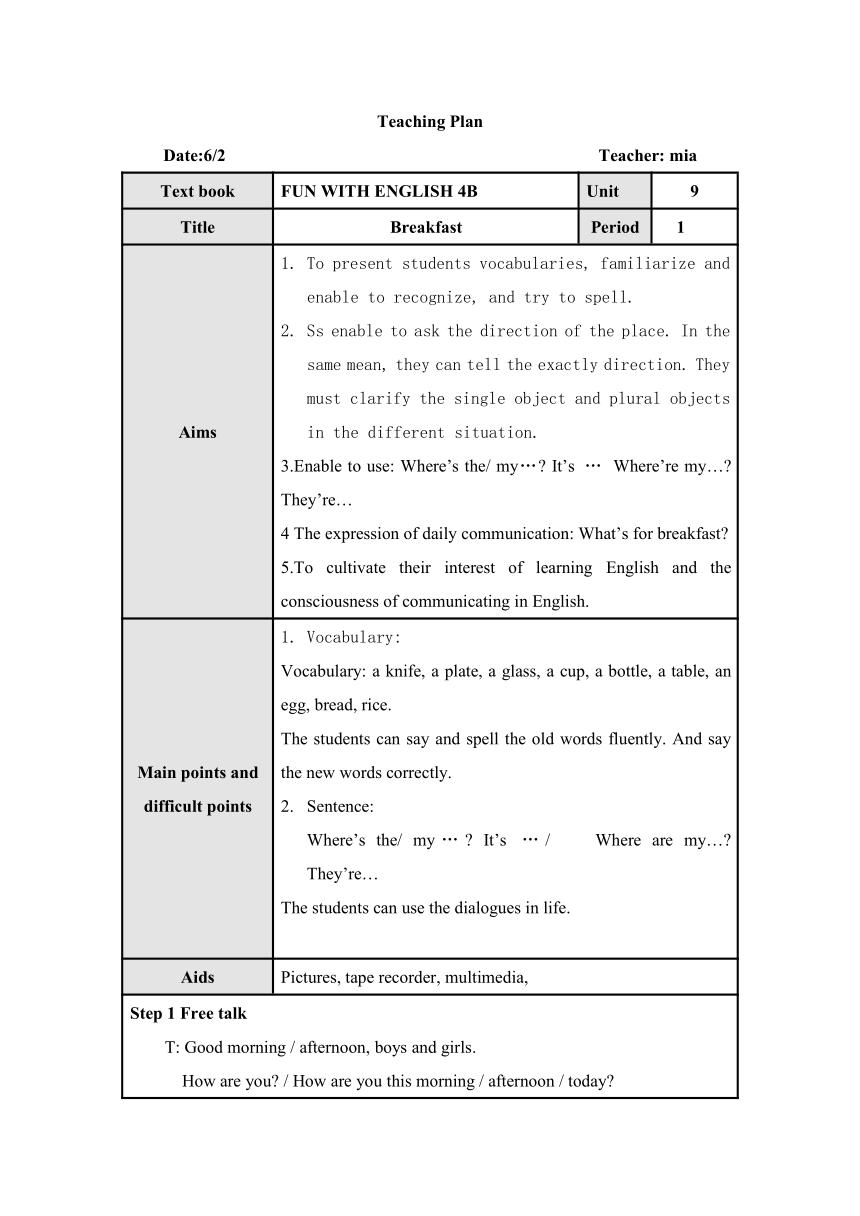 | |
| 格式 | zip | ||
| 文件大小 | 23.8KB | ||
| 资源类型 | 教案 | ||
| 版本资源 | 牛津苏教版 | ||
| 科目 | 英语 | ||
| 更新时间 | 2012-02-02 08:29:56 | ||
图片预览

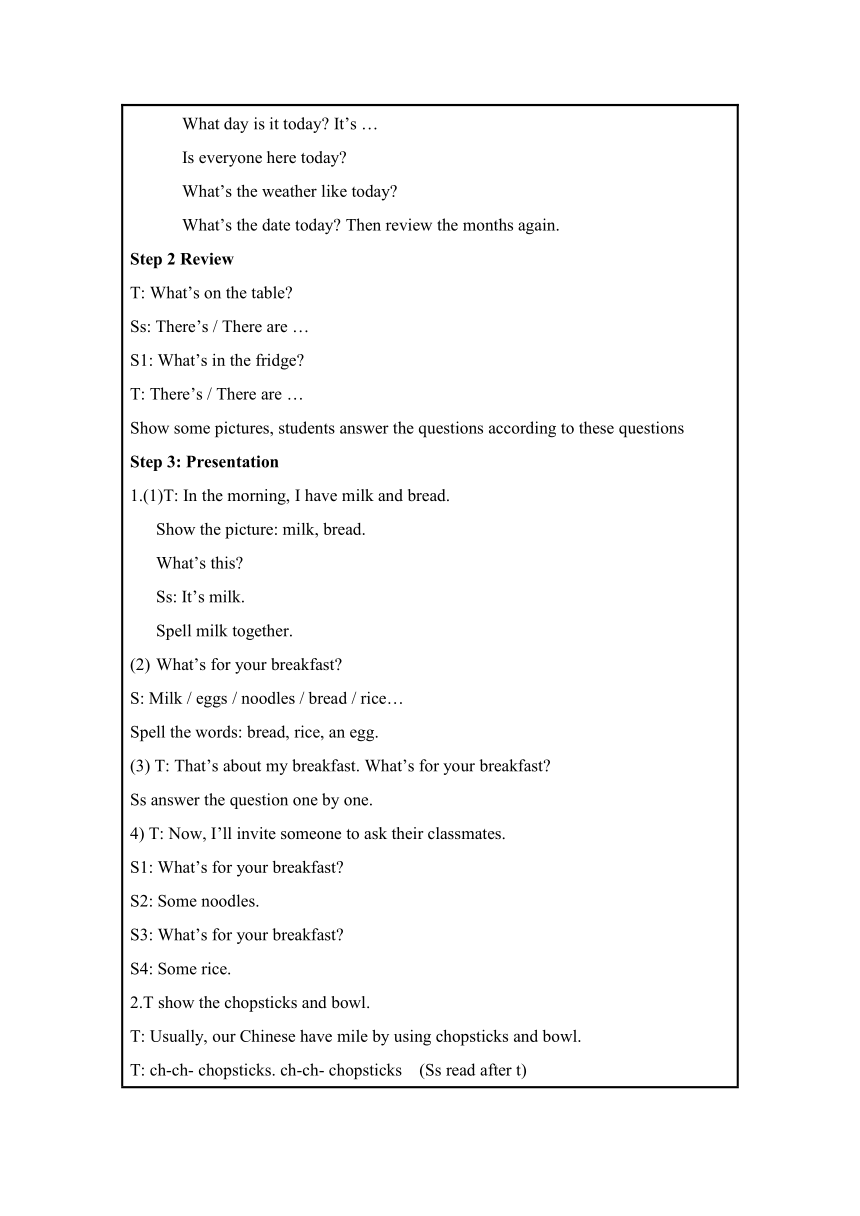
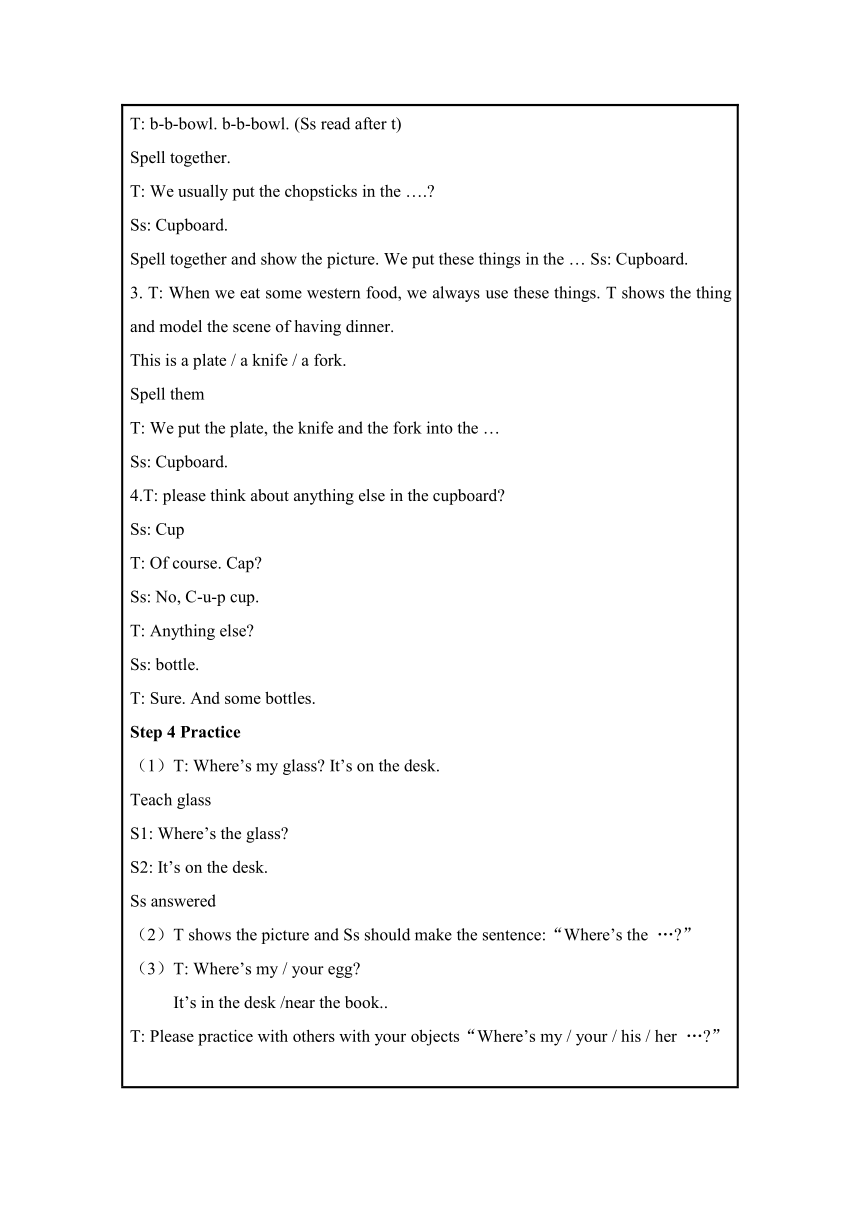
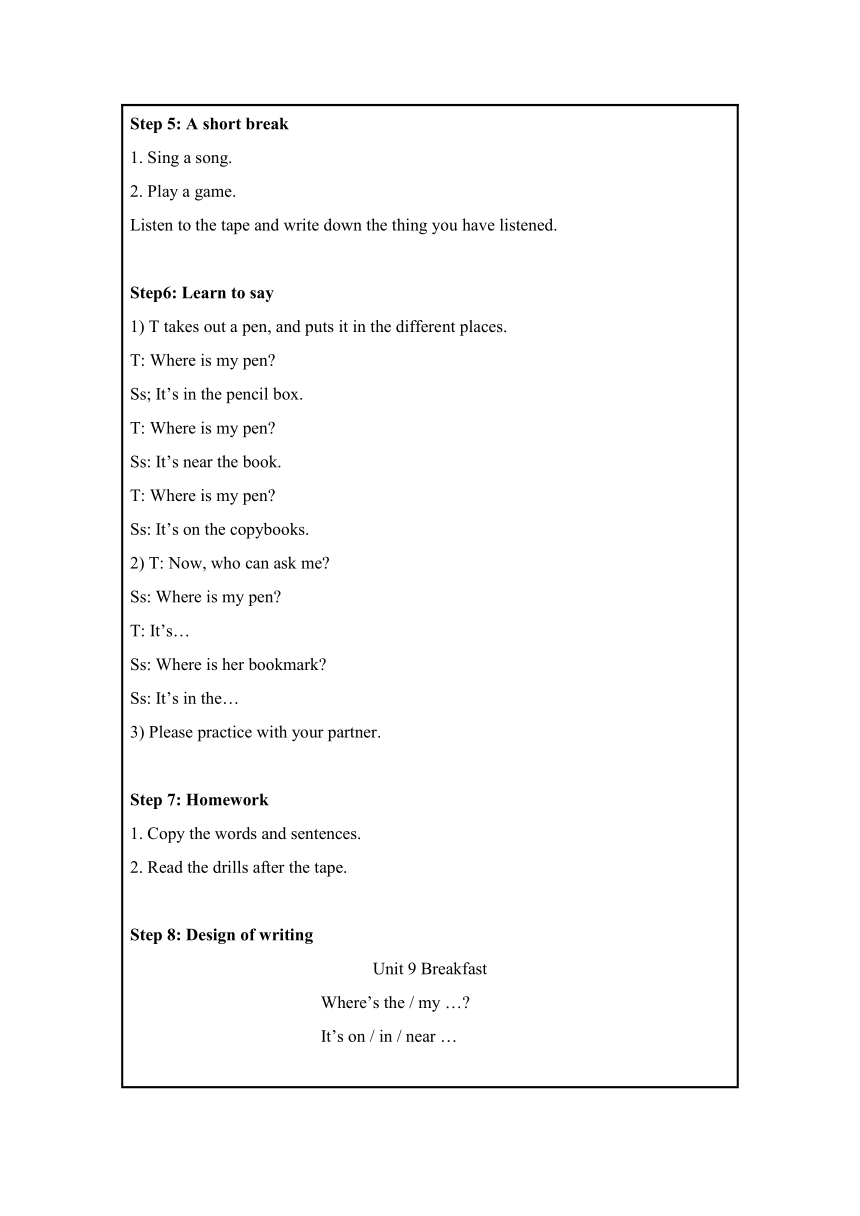
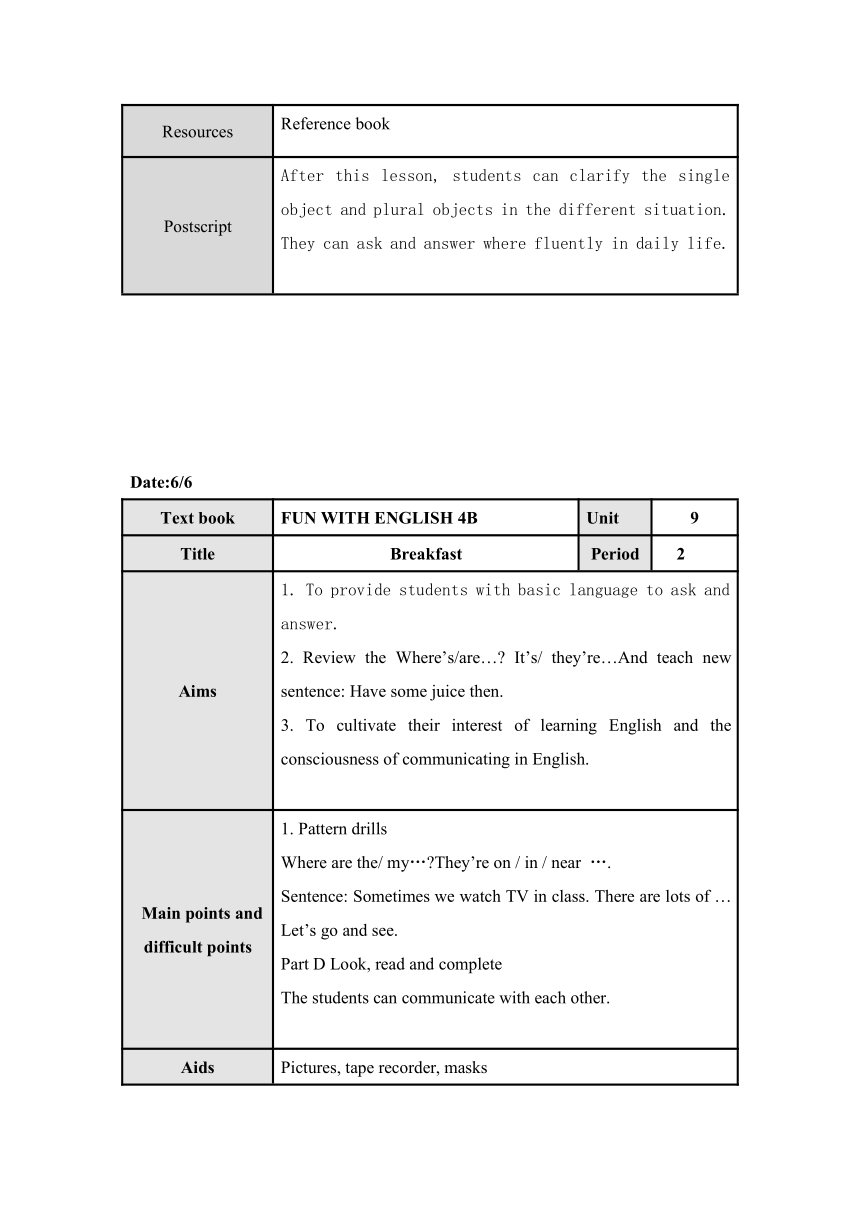
文档简介
Teaching Plan
Date:6/2 Teacher: mia
Text book FUN WITH ENGLISH 4B Unit 9
Title Breakfast Period 1
Aims To present students vocabularies, familiarize and enable to recognize, and try to spell.Ss enable to ask the direction of the place. In the same mean, they can tell the exactly direction. They must clarify the single object and plural objects in the different situation.3.Enable to use: Where’s the/ my… It’s … Where’re my… They’re…4 The expression of daily communication: What’s for breakfast 5.To cultivate their interest of learning English and the consciousness of communicating in English.
Main points and difficult points Vocabulary: Vocabulary: a knife, a plate, a glass, a cup, a bottle, a table, an egg, bread, rice.The students can say and spell the old words fluently. And say the new words correctly.Sentence: Where’s the/ my… It’s …/ Where are my… They’re…The students can use the dialogues in life.
Aids Pictures, tape recorder, multimedia,
Step 1 Free talkT: Good morning / afternoon, boys and girls. How are you / How are you this morning / afternoon / today What day is it today It’s …Is everyone here today What’s the weather like today What’s the date today Then review the months again. Step 2 Review T: What’s on the table Ss: There’s / There are … S1: What’s in the fridge T: There’s / There are …Show some pictures, students answer the questions according to these questionsStep 3: Presentation 1.(1)T: In the morning, I have milk and bread.Show the picture: milk, bread.What’s this Ss: It’s milk. Spell milk together.What’s for your breakfast S: Milk / eggs / noodles / bread / rice…Spell the words: bread, rice, an egg.(3) T: That’s about my breakfast. What’s for your breakfast Ss answer the question one by one.4) T: Now, I’ll invite someone to ask their classmates.S1: What’s for your breakfast S2: Some noodles.S3: What’s for your breakfast S4: Some rice.2.T show the chopsticks and bowl.T: Usually, our Chinese have mile by using chopsticks and bowl.T: ch-ch- chopsticks. ch-ch- chopsticks (Ss read after t) T: b-b-bowl. b-b-bowl. (Ss read after t)Spell together. T: We usually put the chopsticks in the …. Ss: Cupboard.Spell together and show the picture. We put these things in the … Ss: Cupboard.3. T: When we eat some western food, we always use these things. T shows the thing and model the scene of having dinner. This is a plate / a knife / a fork.Spell them T: We put the plate, the knife and the fork into the …Ss: Cupboard.4.T: please think about anything else in the cupboard Ss: Cup T: Of course. Cap Ss: No, C-u-p cup.T: Anything else Ss: bottle.T: Sure. And some bottles.Step 4 Practice(1)T: Where’s my glass It’s on the desk.Teach glassS1: Where’s the glass S2: It’s on the desk.Ss answered(2)T shows the picture and Ss should make the sentence:“Where’s the … ”(3)T: Where’s my / your egg It’s in the desk /near the book..T: Please practice with others with your objects“Where’s my / your / his / her … ”Step 5: A short break1. Sing a song.2. Play a game.Listen to the tape and write down the thing you have listened.Step6: Learn to say1) T takes out a pen, and puts it in the different places.T: Where is my pen Ss; It’s in the pencil box.T: Where is my pen Ss: It’s near the book.T: Where is my pen Ss: It’s on the copybooks.2) T: Now, who can ask me Ss: Where is my pen T: It’s…Ss: Where is her bookmark Ss: It’s in the…3) Please practice with your partner.Step 7: Homework1. Copy the words and sentences.2. Read the drills after the tape.Step 8: Design of writingUnit 9 Breakfast Where’s the / my … It’s on / in / near …
Resources Reference book
Postscript After this lesson, students can clarify the single object and plural objects in the different situation. They can ask and answer where fluently in daily life.
Date:6/6
Text book FUN WITH ENGLISH 4B Unit 9
Title Breakfast Period 2
Aims 1. To provide students with basic language to ask and answer.2. Review the Where’s/are… It’s/ they’re…And teach new sentence: Have some juice then.3. To cultivate their interest of learning English and the consciousness of communicating in English.
Main points and difficult points 1. Pattern drillsWhere are the/ my… They’re on / in / near …. Sentence: Sometimes we watch TV in class. There are lots of … Let’s go and see.Part D Look, read and completeThe students can communicate with each other.
Aids Pictures, tape recorder, masks
Step 1: Warm upDaily ReportReview Show a table and ask: What’s on the table There’s a bottle/bowl/chopsticks on the table. What’s in the cupboard There’s … There are … in the cupboard.Then spell the new words one by one.Step 2: Presentation and practice.What’s this It’s a bottle. Where’s the bottle It’s on the table. What are they They are chopsticks. Where are the chopsticks They are….T: Where’s the rice It’s in the bowl. (Show the picture)T: Where’s the spoon S: It’s in the bowl.T writes down the sentence:“Where are the chopsticks ”3(1)T shows some other pictures. (Choose Ss to Ss to play continue this dialogue)S1: Where are the … S2: They’re on / in / near…(2) T: Look, this is my fridge. (show the picture)T: Where are my apples Ss: They’re in the fridge.T: Where’re my eggs Ss: They’re in the fridge.T: Where are your bananas S: They’re in the desk.Please use your own things to ask and answer:“Where are my / your / his / her … ”Ss practice in pairs and choose someone work in pairs4. (1) T: Where’s my tea S: It’s in the cup.T shows the empty cup.T:There’s no tea in the cup.Ss make sentence by using: There’s no… on/ in / near…(2) S: There’s no milk in the glass.T: Have some juice then.There’s a carton of juice on the desk.Practice: Put a water bottle on the desk. Students try to say: There’s a water bottle on the desk. Then take the water bottle away: T: Is there a water bottle on the desk Ss: No. T: There’s no water bottle on the table. Wrtie the sentence pattern on the Bb. There’s no….Step3: A short breakSing “In the classroom.”Step4: Learn to say1. T: What’s for lunch S: Rice.T: Where’s the rice S: It’s in the white bowl.Write down the words: what where which white and conclude the pronunciation of: whwh pronounce:/w/ e.g.: wheel, why…wh pronounce: /h/ e.g.:who, whose…Please write down more words begin with: wh, and write down in the different places.2. Listen and repeat. Read after the tape.Open the books, read Unit 9 after the tape.Step5: Homework1.Copy the words and sentences.2.Read Unit 9.
Step 6 Design of writing Unit 9 Breakfast Where are the / my … They’re on / in / near …There’s no … in /on / near …
Resources Fun with English VCD
Postscript “no” can connect with countable and uncountable words. After exercise I find that plate should use the prep. “on” because the plate is flat.
Date:6/8
Text book FUN WITH ENGLISH 4B Unit 9
Title Breakfast Period 3
Aims Review the pattern drills: Where is / are … They’re/It’s …in/ on/ near … Try to make new dialogues with the sentences above correctly and properly2. Daily communications and expressions: There’s no…in/ on…3.Review the words in this Unit.
Main points and difficult points 1. SentencesWhat’s in the classroom There is / are …Where is / are … They’re/It’s …in/ on/ near …Ss enable to make dialogue with partner. The students can make the dialogues fluently.
Aids Pictures, tape recorder, masks
Step 1: Sing a songSing “ In the classroom.”Step 2: ReviewFree talk.T: How are you What’s the weather like today Nice to meet you.Ss: Fine.Ss: Sunny/ cloudy/rainySs: Nice to meet you.2.What’s for your breakfast, everyday What’s for lunch Students try to answer, T teaches them some new words about that: poridge, ham, vegetable, meat….Step3: Ask and answer1. (1) T: I’m hungry. I want to eat eggs. But where’s the egg Ss answer the question: It’s in the bowl. Ss do the chain work:“Where’s the egg ”(2) T adds an egg into the bowl and ask:T: Where are the eggs S: They’re in the bowl.2. T uses the picture, and ask:S1: Where’s the knife S2: It’s on the sofa.Practice the sentence: Where’s / Where are the … 3. T: Where’s my banana S: It’s on the desk.T: Where are her apples S: They’re in the fridge.4: Require Ss to make sentence by using sentence: Where’s my / your / his / her … and Where are my /your / his / her … 5. Say a rhymePizza and bread, they are Western food.Rice and noodles, they are Chinese food.Cola and juice, they are soft drinks.Apples and pears, they are nice fruitsStep4: Look and say1.T: I’m thirsty. I want to drink some coffee.S: There’s some coffee in the cup.T: Oh, there’s no coffee in the cup.S: Have some juice then.Practice “There’s no coffee in the cup.”2 Show the pictures and practice.There’s no … in/ on…3. Listen to the tape of Part 1, then do the ask some question:What’s for the breakfast Ss: Milk, bread and eggs.Where are the eggs Ss: They’re on the tables.Where’s my glass Ss: It’s in the cupboard.Where’s the milk Ss: It’s in the fridge.Read the dialogue after the tape several times.4.Make a dialogueRequire Ss to make dialogue by using: Where’s / Where are the …?And sentence: There’s no … in/ on… Then make performance.Step5: Homework1.Copy the sentences.2. Act the dialogue.Step 6 Design of writingUnit 9 Breakfast Where’s the egg / knife… It’s on the plate / sofa…Where are my eggs / apples… They’re on the plate / sofa…
Resources Fun with English VCD
Postscript After learning this unit, students get to know more about the pattern drill There be. They can use different sentences to express the same meaning. Also they learn some daily expressions like What’s for breakfast Can you use chopsticks I’d like to try. and so on. It’s easy for them to learn how to use Where is / are… now the students are familiar with the singular or the plural forms. And they can use them properly and correctly.
Date:6/9
Text book FUN WITH ENGLISH 4B Unit 9
Title Breakfast Period 4
Aims Review all the words, and sentences, and grammar.Sentences: Can you use chopsticks No, I can’t. But I’d like to try. Watch me. Let me try again. Sing a song: It’s one in the afternoon..
Main points and difficult points Pronunciation
Aids Pictures, tape recorder, multimedia,
Step 1: Review1. Sing a song: Western food and Chinese food.2. Act the dialogue.Ss make sentence by using their own things.Step2: Presentation and practice.1.(1)T: Look, here’s a pair of chopsticks.Can you use chopsticks S: Yes, I can.T asks them several times“Can you use … ”(2) Ss practice these sentences with their partners. S: Can you use the knife T:No, I can’t. But I’d like to try. Please you do. OK. Watch me. Is this right S: No.T: Let me try again. Is it right S: Yes.T explains the meaning of: I’d like to try. And Watch me.2. Listen to the tape and try to answer question. Read the context as different characters.3. Look and read.The students look at the pictures. Read themselves. Then they translate the meaning. At last, they read the dialogue.Step3: A short breakPlay a gameT: Close your eyes. Where’s / where are the… Step4: 1.Say a rhyme.Learn to say the rhyme “It’s one in the afternoon.”2.Finish off the workbook./EStep5: Homework1.Say a rhyme.2.Recite the drills.Step 6 Writing of design. Unit 9 Breakfast Can you use chopsticks No, I can’t.But I’d like to try. Watch me. Let me try again.一、词组my glass 我的玻璃杯in the cupboard 在碗橱里on the table 在桌子上in the fridge 在冰箱里have some juice 喝一些果汁a carton of orange juice 一盒橙汁use chopsticks 用筷子a pair of chopsticks 一双筷子watch me 看着我my plate 我的盘子my fork 我的叉子have dinner 吃饭(通常指晚餐)close your eyes 闭上你的眼睛in the school bag 在书包里on the desk 在课桌上in the pencil case 在笔袋里one in the afternoon 下午一点钟watch the cartoon 看卡通片play with your balloon 玩你的气球eat your rice with this spoon 用这把勺子吃你的米饭二、句型What’s for breakfast 早餐吃什么?Where’s the milk It’s in the fridge. 牛奶在哪?在冰箱里。There’s no milk in the fridge. 冰箱里没有牛奶。Have some juice then. 那么,喝些果汁吧。But I’d like to try. (I’d like=I would like) 但是我想试试。Here’s a pair of chopsticks for you. 这里有一双筷子给你。Is this right 这样对吗?Let me try again. 让我再试一次。Come and have dinner. 过来吃饭。You can use chopsticks. 你会用筷子。These are my chopsticks. 这些是我的筷子。I can have my dinner now. 现在我能吃我的晚饭了。Don’t watch the cartoon. 不要看卡通片。Don’t play with your balloon.不要玩你的气球。Can you use chopsticks No, I can’t. 你会用筷子吗?不,我不会。Where are the eggs They’re on the table. 鸡蛋在哪里?它们在桌子上。Where’s my glass It’s in the cupboard. 我的玻璃杯在哪里?它在碗橱里。Mr. White, what’s for lunch Where’s my plate Which is my fork 怀特先生,午餐吃什么?我的盘子在哪里?哪一个是我的叉子?三、本单元重点句型Where’s the / my … It’s …Where are the / my … They’re …There’s no … in / on …四、 语法1.掌握Where’s the / my … 和 Where are the / my … 单数和复数的句型,并能相应作出回答It’s …和They’re …2.巩固there be句型,进而学习There’s no … in / on …的句型,掌握本句型与可数名词单数和不可数名词相关联。五、语音 whwhat where which white 注意与who, whose区别
Resources Reference book
Postscript Review all these language points, help them to remember them. Then have a check.
Date:6/2 Teacher: mia
Text book FUN WITH ENGLISH 4B Unit 9
Title Breakfast Period 1
Aims To present students vocabularies, familiarize and enable to recognize, and try to spell.Ss enable to ask the direction of the place. In the same mean, they can tell the exactly direction. They must clarify the single object and plural objects in the different situation.3.Enable to use: Where’s the/ my… It’s … Where’re my… They’re…4 The expression of daily communication: What’s for breakfast 5.To cultivate their interest of learning English and the consciousness of communicating in English.
Main points and difficult points Vocabulary: Vocabulary: a knife, a plate, a glass, a cup, a bottle, a table, an egg, bread, rice.The students can say and spell the old words fluently. And say the new words correctly.Sentence: Where’s the/ my… It’s …/ Where are my… They’re…The students can use the dialogues in life.
Aids Pictures, tape recorder, multimedia,
Step 1 Free talkT: Good morning / afternoon, boys and girls. How are you / How are you this morning / afternoon / today What day is it today It’s …Is everyone here today What’s the weather like today What’s the date today Then review the months again. Step 2 Review T: What’s on the table Ss: There’s / There are … S1: What’s in the fridge T: There’s / There are …Show some pictures, students answer the questions according to these questionsStep 3: Presentation 1.(1)T: In the morning, I have milk and bread.Show the picture: milk, bread.What’s this Ss: It’s milk. Spell milk together.What’s for your breakfast S: Milk / eggs / noodles / bread / rice…Spell the words: bread, rice, an egg.(3) T: That’s about my breakfast. What’s for your breakfast Ss answer the question one by one.4) T: Now, I’ll invite someone to ask their classmates.S1: What’s for your breakfast S2: Some noodles.S3: What’s for your breakfast S4: Some rice.2.T show the chopsticks and bowl.T: Usually, our Chinese have mile by using chopsticks and bowl.T: ch-ch- chopsticks. ch-ch- chopsticks (Ss read after t) T: b-b-bowl. b-b-bowl. (Ss read after t)Spell together. T: We usually put the chopsticks in the …. Ss: Cupboard.Spell together and show the picture. We put these things in the … Ss: Cupboard.3. T: When we eat some western food, we always use these things. T shows the thing and model the scene of having dinner. This is a plate / a knife / a fork.Spell them T: We put the plate, the knife and the fork into the …Ss: Cupboard.4.T: please think about anything else in the cupboard Ss: Cup T: Of course. Cap Ss: No, C-u-p cup.T: Anything else Ss: bottle.T: Sure. And some bottles.Step 4 Practice(1)T: Where’s my glass It’s on the desk.Teach glassS1: Where’s the glass S2: It’s on the desk.Ss answered(2)T shows the picture and Ss should make the sentence:“Where’s the … ”(3)T: Where’s my / your egg It’s in the desk /near the book..T: Please practice with others with your objects“Where’s my / your / his / her … ”Step 5: A short break1. Sing a song.2. Play a game.Listen to the tape and write down the thing you have listened.Step6: Learn to say1) T takes out a pen, and puts it in the different places.T: Where is my pen Ss; It’s in the pencil box.T: Where is my pen Ss: It’s near the book.T: Where is my pen Ss: It’s on the copybooks.2) T: Now, who can ask me Ss: Where is my pen T: It’s…Ss: Where is her bookmark Ss: It’s in the…3) Please practice with your partner.Step 7: Homework1. Copy the words and sentences.2. Read the drills after the tape.Step 8: Design of writingUnit 9 Breakfast Where’s the / my … It’s on / in / near …
Resources Reference book
Postscript After this lesson, students can clarify the single object and plural objects in the different situation. They can ask and answer where fluently in daily life.
Date:6/6
Text book FUN WITH ENGLISH 4B Unit 9
Title Breakfast Period 2
Aims 1. To provide students with basic language to ask and answer.2. Review the Where’s/are… It’s/ they’re…And teach new sentence: Have some juice then.3. To cultivate their interest of learning English and the consciousness of communicating in English.
Main points and difficult points 1. Pattern drillsWhere are the/ my… They’re on / in / near …. Sentence: Sometimes we watch TV in class. There are lots of … Let’s go and see.Part D Look, read and completeThe students can communicate with each other.
Aids Pictures, tape recorder, masks
Step 1: Warm upDaily ReportReview Show a table and ask: What’s on the table There’s a bottle/bowl/chopsticks on the table. What’s in the cupboard There’s … There are … in the cupboard.Then spell the new words one by one.Step 2: Presentation and practice.What’s this It’s a bottle. Where’s the bottle It’s on the table. What are they They are chopsticks. Where are the chopsticks They are….T: Where’s the rice It’s in the bowl. (Show the picture)T: Where’s the spoon S: It’s in the bowl.T writes down the sentence:“Where are the chopsticks ”3(1)T shows some other pictures. (Choose Ss to Ss to play continue this dialogue)S1: Where are the … S2: They’re on / in / near…(2) T: Look, this is my fridge. (show the picture)T: Where are my apples Ss: They’re in the fridge.T: Where’re my eggs Ss: They’re in the fridge.T: Where are your bananas S: They’re in the desk.Please use your own things to ask and answer:“Where are my / your / his / her … ”Ss practice in pairs and choose someone work in pairs4. (1) T: Where’s my tea S: It’s in the cup.T shows the empty cup.T:There’s no tea in the cup.Ss make sentence by using: There’s no… on/ in / near…(2) S: There’s no milk in the glass.T: Have some juice then.There’s a carton of juice on the desk.Practice: Put a water bottle on the desk. Students try to say: There’s a water bottle on the desk. Then take the water bottle away: T: Is there a water bottle on the desk Ss: No. T: There’s no water bottle on the table. Wrtie the sentence pattern on the Bb. There’s no….Step3: A short breakSing “In the classroom.”Step4: Learn to say1. T: What’s for lunch S: Rice.T: Where’s the rice S: It’s in the white bowl.Write down the words: what where which white and conclude the pronunciation of: whwh pronounce:/w/ e.g.: wheel, why…wh pronounce: /h/ e.g.:who, whose…Please write down more words begin with: wh, and write down in the different places.2. Listen and repeat. Read after the tape.Open the books, read Unit 9 after the tape.Step5: Homework1.Copy the words and sentences.2.Read Unit 9.
Step 6 Design of writing Unit 9 Breakfast Where are the / my … They’re on / in / near …There’s no … in /on / near …
Resources Fun with English VCD
Postscript “no” can connect with countable and uncountable words. After exercise I find that plate should use the prep. “on” because the plate is flat.
Date:6/8
Text book FUN WITH ENGLISH 4B Unit 9
Title Breakfast Period 3
Aims Review the pattern drills: Where is / are … They’re/It’s …in/ on/ near … Try to make new dialogues with the sentences above correctly and properly2. Daily communications and expressions: There’s no…in/ on…3.Review the words in this Unit.
Main points and difficult points 1. SentencesWhat’s in the classroom There is / are …Where is / are … They’re/It’s …in/ on/ near …Ss enable to make dialogue with partner. The students can make the dialogues fluently.
Aids Pictures, tape recorder, masks
Step 1: Sing a songSing “ In the classroom.”Step 2: ReviewFree talk.T: How are you What’s the weather like today Nice to meet you.Ss: Fine.Ss: Sunny/ cloudy/rainySs: Nice to meet you.2.What’s for your breakfast, everyday What’s for lunch Students try to answer, T teaches them some new words about that: poridge, ham, vegetable, meat….Step3: Ask and answer1. (1) T: I’m hungry. I want to eat eggs. But where’s the egg Ss answer the question: It’s in the bowl. Ss do the chain work:“Where’s the egg ”(2) T adds an egg into the bowl and ask:T: Where are the eggs S: They’re in the bowl.2. T uses the picture, and ask:S1: Where’s the knife S2: It’s on the sofa.Practice the sentence: Where’s / Where are the … 3. T: Where’s my banana S: It’s on the desk.T: Where are her apples S: They’re in the fridge.4: Require Ss to make sentence by using sentence: Where’s my / your / his / her … and Where are my /your / his / her … 5. Say a rhymePizza and bread, they are Western food.Rice and noodles, they are Chinese food.Cola and juice, they are soft drinks.Apples and pears, they are nice fruitsStep4: Look and say1.T: I’m thirsty. I want to drink some coffee.S: There’s some coffee in the cup.T: Oh, there’s no coffee in the cup.S: Have some juice then.Practice “There’s no coffee in the cup.”2 Show the pictures and practice.There’s no … in/ on…3. Listen to the tape of Part 1, then do the ask some question:What’s for the breakfast Ss: Milk, bread and eggs.Where are the eggs Ss: They’re on the tables.Where’s my glass Ss: It’s in the cupboard.Where’s the milk Ss: It’s in the fridge.Read the dialogue after the tape several times.4.Make a dialogueRequire Ss to make dialogue by using: Where’s / Where are the …?And sentence: There’s no … in/ on… Then make performance.Step5: Homework1.Copy the sentences.2. Act the dialogue.Step 6 Design of writingUnit 9 Breakfast Where’s the egg / knife… It’s on the plate / sofa…Where are my eggs / apples… They’re on the plate / sofa…
Resources Fun with English VCD
Postscript After learning this unit, students get to know more about the pattern drill There be. They can use different sentences to express the same meaning. Also they learn some daily expressions like What’s for breakfast Can you use chopsticks I’d like to try. and so on. It’s easy for them to learn how to use Where is / are… now the students are familiar with the singular or the plural forms. And they can use them properly and correctly.
Date:6/9
Text book FUN WITH ENGLISH 4B Unit 9
Title Breakfast Period 4
Aims Review all the words, and sentences, and grammar.Sentences: Can you use chopsticks No, I can’t. But I’d like to try. Watch me. Let me try again. Sing a song: It’s one in the afternoon..
Main points and difficult points Pronunciation
Aids Pictures, tape recorder, multimedia,
Step 1: Review1. Sing a song: Western food and Chinese food.2. Act the dialogue.Ss make sentence by using their own things.Step2: Presentation and practice.1.(1)T: Look, here’s a pair of chopsticks.Can you use chopsticks S: Yes, I can.T asks them several times“Can you use … ”(2) Ss practice these sentences with their partners. S: Can you use the knife T:No, I can’t. But I’d like to try. Please you do. OK. Watch me. Is this right S: No.T: Let me try again. Is it right S: Yes.T explains the meaning of: I’d like to try. And Watch me.2. Listen to the tape and try to answer question. Read the context as different characters.3. Look and read.The students look at the pictures. Read themselves. Then they translate the meaning. At last, they read the dialogue.Step3: A short breakPlay a gameT: Close your eyes. Where’s / where are the… Step4: 1.Say a rhyme.Learn to say the rhyme “It’s one in the afternoon.”2.Finish off the workbook./EStep5: Homework1.Say a rhyme.2.Recite the drills.Step 6 Writing of design. Unit 9 Breakfast Can you use chopsticks No, I can’t.But I’d like to try. Watch me. Let me try again.一、词组my glass 我的玻璃杯in the cupboard 在碗橱里on the table 在桌子上in the fridge 在冰箱里have some juice 喝一些果汁a carton of orange juice 一盒橙汁use chopsticks 用筷子a pair of chopsticks 一双筷子watch me 看着我my plate 我的盘子my fork 我的叉子have dinner 吃饭(通常指晚餐)close your eyes 闭上你的眼睛in the school bag 在书包里on the desk 在课桌上in the pencil case 在笔袋里one in the afternoon 下午一点钟watch the cartoon 看卡通片play with your balloon 玩你的气球eat your rice with this spoon 用这把勺子吃你的米饭二、句型What’s for breakfast 早餐吃什么?Where’s the milk It’s in the fridge. 牛奶在哪?在冰箱里。There’s no milk in the fridge. 冰箱里没有牛奶。Have some juice then. 那么,喝些果汁吧。But I’d like to try. (I’d like=I would like) 但是我想试试。Here’s a pair of chopsticks for you. 这里有一双筷子给你。Is this right 这样对吗?Let me try again. 让我再试一次。Come and have dinner. 过来吃饭。You can use chopsticks. 你会用筷子。These are my chopsticks. 这些是我的筷子。I can have my dinner now. 现在我能吃我的晚饭了。Don’t watch the cartoon. 不要看卡通片。Don’t play with your balloon.不要玩你的气球。Can you use chopsticks No, I can’t. 你会用筷子吗?不,我不会。Where are the eggs They’re on the table. 鸡蛋在哪里?它们在桌子上。Where’s my glass It’s in the cupboard. 我的玻璃杯在哪里?它在碗橱里。Mr. White, what’s for lunch Where’s my plate Which is my fork 怀特先生,午餐吃什么?我的盘子在哪里?哪一个是我的叉子?三、本单元重点句型Where’s the / my … It’s …Where are the / my … They’re …There’s no … in / on …四、 语法1.掌握Where’s the / my … 和 Where are the / my … 单数和复数的句型,并能相应作出回答It’s …和They’re …2.巩固there be句型,进而学习There’s no … in / on …的句型,掌握本句型与可数名词单数和不可数名词相关联。五、语音 whwhat where which white 注意与who, whose区别
Resources Reference book
Postscript Review all these language points, help them to remember them. Then have a check.
